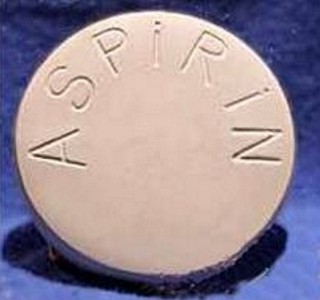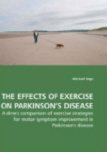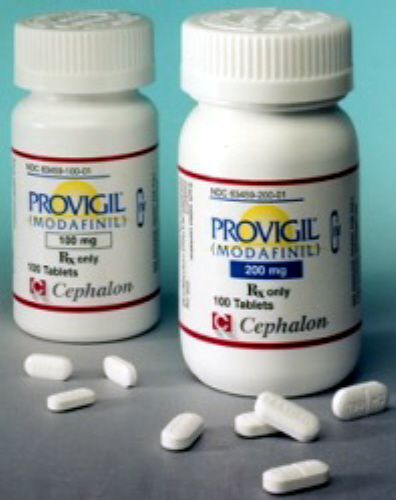|
MARCH
2010
27th March 2010 - New research
ANTI-INFLAMMATORY DRUGS FOR PARKINSON'S DISEASE
Neurology [2010] 74 (12) : 995-1002 (Gagne JJ,
Power MC.)
Complete abstract
It has been claimed that anti-inflammatory drugs may prevent Parkinson Disease
by inhibiting an underlying neuro-inflammatory process. This theory was tested
according to the type of anti-inflammatory drug, the duration of use, and the
intensity of use. All relevant clinical studies were assessed.
 Seven studies
reported
associations between non-aspirin non-steroidal anti-inflammatory drugs (NSAIDs)
and Parkinson's Disease. Six of them reported aspirin. Two of them reported
acetaminophen. There was a 15% reduction
in the incidence of Parkinson's Disease among users of non-aspirin NSAIDS. A similar effect
was observed for Ibuprofen use. The reduction in the incidence of Parkinson's
Disease was greater (21%) in long term users, and even greater than that (29%)
in regular users. However, for people who already had Parkinson's Disease, the
use of aspirin or acetaminophen made no difference at all. This is contrary to
the claim that there is an inflammatory problem in Parkinson's Disease.
In order to refer to this
article on its own
click here. Seven studies
reported
associations between non-aspirin non-steroidal anti-inflammatory drugs (NSAIDs)
and Parkinson's Disease. Six of them reported aspirin. Two of them reported
acetaminophen. There was a 15% reduction
in the incidence of Parkinson's Disease among users of non-aspirin NSAIDS. A similar effect
was observed for Ibuprofen use. The reduction in the incidence of Parkinson's
Disease was greater (21%) in long term users, and even greater than that (29%)
in regular users. However, for people who already had Parkinson's Disease, the
use of aspirin or acetaminophen made no difference at all. This is contrary to
the claim that there is an inflammatory problem in Parkinson's Disease.
In order to refer to this
article on its own
click here.
24th March 2010 - New research
THE RISK OF DEVELOPING
DYSKINESIA IN PARKINSON'S DISEASE
Movement Disorders
[2010]
Mar 22. [Epub ahead of print] (Ku S, Glass GA.)
Complete abstract
The risk of developing dyskinesia due to taking L-dopa is known to vary
inversely with the age of Parkinson's Disease onset. Basically, the younger
somebody is when they develop Parkinson's Disease the more likely they are to
subsequently develop dyskinesia. Dyskinesia is abnormal and involuntary
physical movements such as those shown by Michael J.Fox in this
interview.
 After 5 years of L-dopa treatment, the dyskinesia
risk for patients with onset age
40-49
was high, at 70%. For those diagnosed between 50-59 years old the risk of
developing dyskinesia decreased to 42%. The risk decreased further still for
those diagnosed between 60-69 years old to 33%. Least at risk were those
diagnosed between 70-79 years old, who had only a 24% risk of developing
dyskinesia. After 5 years of L-dopa, dyskinesia risks became uniformly high
regardless of age of onset. After 5 years of L-dopa treatment, the dyskinesia
risk for patients with onset age
40-49
was high, at 70%. For those diagnosed between 50-59 years old the risk of
developing dyskinesia decreased to 42%. The risk decreased further still for
those diagnosed between 60-69 years old to 33%. Least at risk were those
diagnosed between 70-79 years old, who had only a 24% risk of developing
dyskinesia. After 5 years of L-dopa, dyskinesia risks became uniformly high
regardless of age of onset.
So lengthy use of L-dopa by those diagnosed at an
early age was by far the most likely to cause dyskinesia.
In order to refer to this
article on its own
click here.
16th March 2010 - New book
DEEP BRAIN DIARY :
MY LIFE AS A GUY WITH PARKINSON'S DISEASE AND BRAIN SURGERY VOLUNTEER
Bill Schmalfeldt
 Publisher's
description :
It was nearly four weeks after his 45th
birthday when Bill Schmalfeldt was diagnosed with Parkinson's disease. In
addition to having to get used to having what he always thought of as a old
man's disease, Bill had to adjust to the idea that his condition would only
deteriorate. After seven years, Bill learned about an experimental clinical
trial of deep brain stimulation for patients in the less-advanced stages of
Parkinson's. He was one of 30 people to sign up for this Phase I trial testing
the safety and tolerability of the procedure.
Bill takes you into the operating room
with him, remaining awake as twin probes are carefully advanced deep into the
subthalamic nuclei of his brain. He also shares his life before the
surgery and his life afterwards including the mixed results he is currently
experiencing.
Click here for more details. The
author's proceeds will be donated to the National
Parkinson Foundation.
For
more books concerning Parkinson's Disease go to
Parkinson's Disease Books. Publisher's
description :
It was nearly four weeks after his 45th
birthday when Bill Schmalfeldt was diagnosed with Parkinson's disease. In
addition to having to get used to having what he always thought of as a old
man's disease, Bill had to adjust to the idea that his condition would only
deteriorate. After seven years, Bill learned about an experimental clinical
trial of deep brain stimulation for patients in the less-advanced stages of
Parkinson's. He was one of 30 people to sign up for this Phase I trial testing
the safety and tolerability of the procedure.
Bill takes you into the operating room
with him, remaining awake as twin probes are carefully advanced deep into the
subthalamic nuclei of his brain. He also shares his life before the
surgery and his life afterwards including the mixed results he is currently
experiencing.
Click here for more details. The
author's proceeds will be donated to the National
Parkinson Foundation.
For
more books concerning Parkinson's Disease go to
Parkinson's Disease Books.
The author, Bill
Schmalfeldt
is a 55-year old federal writer-editor who was
diagnosed with Parkinsonís Disease ten years ago. He
has a Parkinson's Disease web site, that details different aspects of life with
Parkinson's Disease
here.
14th March 2010 - New book
COGNITIVE IMPAIRMENT AND DEMENTIA IN PARKINSON'S DISEASE
Murat Emre
 Publisher's
description : This book provides an extensive overview of the cognitive
impairment and dementia associated with Parkinson's disease. Experts in the
field describe in detail all aspects of cognitive impairment and dementia in
Parkinson's disease, including epidemiology, spectrum of clinical features,
pathology, neurochemistry and genetics, findings in auxiliary investigations,
relation to other neurodegenerative disorders, diagnostic process and
management, and rounded up by discussion of future research directions and
expectations. The text is complemented and enriched with tables, figures and
fully referenced to encompass all relevant literature.
Click here for more details. For more books concerning Parkinson's Disease go to
Parkinson's Disease Books. Publisher's
description : This book provides an extensive overview of the cognitive
impairment and dementia associated with Parkinson's disease. Experts in the
field describe in detail all aspects of cognitive impairment and dementia in
Parkinson's disease, including epidemiology, spectrum of clinical features,
pathology, neurochemistry and genetics, findings in auxiliary investigations,
relation to other neurodegenerative disorders, diagnostic process and
management, and rounded up by discussion of future research directions and
expectations. The text is complemented and enriched with tables, figures and
fully referenced to encompass all relevant literature.
Click here for more details. For more books concerning Parkinson's Disease go to
Parkinson's Disease Books.
12th March 2010 - New research
THE RATE OF PROGRESSION OF
PARKINSON'S DISEASE
Movement Disorders
[2010]
Mar 8. [Epub ahead of print] (Zhao YJ, Wee HL, Chan
YH, Seah SH, Au WL, Lau PN, Pica EC, Li SC, Luo N, Tan LC.)
Complete abstract
This study was carried out to evaluate the rate of
progression in Parkinson's Disease. What was analysed was the time taken to
progress from one stage of the Hoehn and Yahr scale to the next.
The Hoen and Yahr
characterises patients according to a scale of five stages of severity, from
Stage 1, which is mild, to Stage 5, which is incapacitated.
For the questionnaire go to the
Hoehn and Yahr scale.
 The average time taken to progress from Stage 1 (mild) to
Stage
2 (mild but various symptoms) was 1 year 8 months. The average time taken
to progress from Stage 2 to Stage 3 (typical) was 7 years and 3 months.
From Stage 3 to Stage 4 (severe) took 2 years. From Stage 4 to Stage 5
(incapacitated) took 2 years and 2 months. So the stage with typical symptoms
lasts the longest. Those factors associated with faster progression were older
age at diagnosis, and longer disease duration. Gender and ethnicity were not
associated with the rate of Parkinson's Disease progression. The average time taken to progress from Stage 1 (mild) to
Stage
2 (mild but various symptoms) was 1 year 8 months. The average time taken
to progress from Stage 2 to Stage 3 (typical) was 7 years and 3 months.
From Stage 3 to Stage 4 (severe) took 2 years. From Stage 4 to Stage 5
(incapacitated) took 2 years and 2 months. So the stage with typical symptoms
lasts the longest. Those factors associated with faster progression were older
age at diagnosis, and longer disease duration. Gender and ethnicity were not
associated with the rate of Parkinson's Disease progression.
These figures are
only averages. Progression is not inevitable. Some people with Parkinson's
Disease have either : stayed the same for decades, reduced their symptoms, rid
their symptoms, or worsened at a rapid rate.
In order to refer to this
article on its own
click here.
10th March 2010 - New research
PARDOPRUNOX - A PARTIAL DOPAMINE
AGONIST FOR
PARKINSON'S DISEASE
Movement Disorders
[2010]
Mar 2. [Epub ahead of print] (Bronzova J, Sampaio
C, Hauser RA, Lang AE, Rascol O, Theeuwes A, van de Witte SV, van Scharrenburg
G)
Complete abstract
Pardoprunox is a new partial dopamine agonist from Solvay being assessed for its
potential future use in the treatment of Parkinson's Disease. It unusually
combines two effects as if it were two distinct but combined drugs :
partially stimulating dopamine, whose deficiency causes Parkinson's Disease, and
fully stimulating serotonin, which
is another chemical naturally produced in the brain.
 It is thought that Pardoprunox could avoid some of the severe
side effects that full dopamine agonists cause by lessening the effect of
dopamine when dopamine activity is high. This study examined the efficacy and
safety of Pardoprunox (SLV308), in the treatment of patients with early
Parkinson's Disease. Parkinson's Disease symptoms did reduce when taking
Pardoprunox. Activities of daily living in
people with Parkinson's Disease also improved. Nausea was reported by 47% of
patients. Dizziness, somnolence, headache, asthenia were reported far less
commonly. The effects of Pardoprunox are to be assessed further.
In order to refer to this
article on its own
click here. It is thought that Pardoprunox could avoid some of the severe
side effects that full dopamine agonists cause by lessening the effect of
dopamine when dopamine activity is high. This study examined the efficacy and
safety of Pardoprunox (SLV308), in the treatment of patients with early
Parkinson's Disease. Parkinson's Disease symptoms did reduce when taking
Pardoprunox. Activities of daily living in
people with Parkinson's Disease also improved. Nausea was reported by 47% of
patients. Dizziness, somnolence, headache, asthenia were reported far less
commonly. The effects of Pardoprunox are to be assessed further.
In order to refer to this
article on its own
click here.
6th March 2010 - New book
THE EFFECTS OF EXERCISE ON PARKINSON'S DISEASE
Michael Sage
 Publisher's
description : This book explores the role of exercise in the treatment and
management of Parkinsonís Disease. Detailed and thorough comparisons are made
between various exercise interventions, including sensory attention focused
exercise (PD SAFEx). PD SAFEx is a novel exercise strategy designed to target
underlying neurophysiological deficits in Parkinsonís disease. Namely, it
targets the disrupted sensorimotor integration in Parkinsonís Disease and
focuses participantsí attention to proprioceptive feedback while in motion. It
was found that PD SAFEx and strength training have the greatest symptomatic
benefit for individuals with Parkinson's Disease.
Click here for more details. For more books concerning Parkinson's Disease go to
Parkinson's Disease Books. Publisher's
description : This book explores the role of exercise in the treatment and
management of Parkinsonís Disease. Detailed and thorough comparisons are made
between various exercise interventions, including sensory attention focused
exercise (PD SAFEx). PD SAFEx is a novel exercise strategy designed to target
underlying neurophysiological deficits in Parkinsonís disease. Namely, it
targets the disrupted sensorimotor integration in Parkinsonís Disease and
focuses participantsí attention to proprioceptive feedback while in motion. It
was found that PD SAFEx and strength training have the greatest symptomatic
benefit for individuals with Parkinson's Disease.
Click here for more details. For more books concerning Parkinson's Disease go to
Parkinson's Disease Books.
3rd March 2010 - New research
MODAFINIL FOR
FATIGUE IN PARKINSON'S DISEASE
Clinical Neuropharmacology
[2009] 32 (6) : 305-310 (Lou JS, Dimitrova DM, Park BS, Johnson SC, Eaton R,
Arnold G, Nutt JG.)
Complete abstract
 Fatigue is a major symptom in Parkinson's
Disease. It is associated with
reduced activity and lower quality of life. Modafinil has been considered for
use in the treatment of fatigue in Parkinson's Disease due to its ability to
release dopamine. For more information go to
Modafinil.
A study has determined whether Modafinil improves
subjective fatigue and physical fatigability in Parkinson's Disease. After a
month Modafinil made no difference. After two months Modafinil helped to some
extent with physical fatigue. However for fatigue generally it still had no
effect. The primary problem in Parkinson's Disease is the inability to produce
optimal dopamine. The reason for the ineffectiveness of Modafinil in
Parkinson's Disease may be due to it only releasing dopamine. It doesn't form
any additional dopamine in order for more to be released.
In order to refer to this
article on its own
click here. Fatigue is a major symptom in Parkinson's
Disease. It is associated with
reduced activity and lower quality of life. Modafinil has been considered for
use in the treatment of fatigue in Parkinson's Disease due to its ability to
release dopamine. For more information go to
Modafinil.
A study has determined whether Modafinil improves
subjective fatigue and physical fatigability in Parkinson's Disease. After a
month Modafinil made no difference. After two months Modafinil helped to some
extent with physical fatigue. However for fatigue generally it still had no
effect. The primary problem in Parkinson's Disease is the inability to produce
optimal dopamine. The reason for the ineffectiveness of Modafinil in
Parkinson's Disease may be due to it only releasing dopamine. It doesn't form
any additional dopamine in order for more to be released.
In order to refer to this
article on its own
click here.
|
.gif)
.gif)
 Seven studies
reported
associations between non-aspirin non-steroidal anti-inflammatory drugs (NSAIDs)
and Parkinson's Disease. Six of them reported aspirin. Two of them reported
acetaminophen. There was a 15% reduction
in the incidence of Parkinson's Disease among users of non-aspirin NSAIDS. A similar effect
was observed for Ibuprofen use. The reduction in the incidence of Parkinson's
Disease was greater (21%) in long term users, and even greater than that (29%)
in regular users. However, for people who already had Parkinson's Disease, the
use of aspirin or acetaminophen made no difference at all. This is contrary to
the claim that there is an inflammatory problem in Parkinson's Disease.
In order to refer to this
article on its own
Seven studies
reported
associations between non-aspirin non-steroidal anti-inflammatory drugs (NSAIDs)
and Parkinson's Disease. Six of them reported aspirin. Two of them reported
acetaminophen. There was a 15% reduction
in the incidence of Parkinson's Disease among users of non-aspirin NSAIDS. A similar effect
was observed for Ibuprofen use. The reduction in the incidence of Parkinson's
Disease was greater (21%) in long term users, and even greater than that (29%)
in regular users. However, for people who already had Parkinson's Disease, the
use of aspirin or acetaminophen made no difference at all. This is contrary to
the claim that there is an inflammatory problem in Parkinson's Disease.
In order to refer to this
article on its own
 After 5 years of L-dopa treatment, the dyskinesia
risk for patients with onset age
40-49
was high, at 70%. For those diagnosed between 50-59 years old the risk of
developing dyskinesia decreased to 42%. The risk decreased further still for
those diagnosed between 60-69 years old to 33%. Least at risk were those
diagnosed between 70-79 years old, who had only a 24% risk of developing
dyskinesia. After 5 years of L-dopa, dyskinesia risks became uniformly high
regardless of age of onset.
After 5 years of L-dopa treatment, the dyskinesia
risk for patients with onset age
40-49
was high, at 70%. For those diagnosed between 50-59 years old the risk of
developing dyskinesia decreased to 42%. The risk decreased further still for
those diagnosed between 60-69 years old to 33%. Least at risk were those
diagnosed between 70-79 years old, who had only a 24% risk of developing
dyskinesia. After 5 years of L-dopa, dyskinesia risks became uniformly high
regardless of age of onset.
 Publisher's
description :
Publisher's
description :
 Publisher's
description : This book provides an extensive overview of the cognitive
impairment and dementia associated with Parkinson's disease. Experts in the
field describe in detail all aspects of cognitive impairment and dementia in
Parkinson's disease, including epidemiology, spectrum of clinical features,
pathology, neurochemistry and genetics, findings in auxiliary investigations,
relation to other neurodegenerative disorders, diagnostic process and
management, and rounded up by discussion of future research directions and
expectations. The text is complemented and enriched with tables, figures and
fully referenced to encompass all relevant literature.
Publisher's
description : This book provides an extensive overview of the cognitive
impairment and dementia associated with Parkinson's disease. Experts in the
field describe in detail all aspects of cognitive impairment and dementia in
Parkinson's disease, including epidemiology, spectrum of clinical features,
pathology, neurochemistry and genetics, findings in auxiliary investigations,
relation to other neurodegenerative disorders, diagnostic process and
management, and rounded up by discussion of future research directions and
expectations. The text is complemented and enriched with tables, figures and
fully referenced to encompass all relevant literature.
 The average time taken to progress from Stage 1 (mild) to
Stage
2 (mild but various symptoms) was 1 year 8 months. The average time taken
to progress from Stage 2 to Stage 3 (typical) was 7 years and 3 months.
From Stage 3 to Stage 4 (severe) took 2 years. From Stage 4 to Stage 5
(incapacitated) took 2 years and 2 months. So the stage with typical symptoms
lasts the longest. Those factors associated with faster progression were older
age at diagnosis, and longer disease duration. Gender and ethnicity were not
associated with the rate of Parkinson's Disease progression.
The average time taken to progress from Stage 1 (mild) to
Stage
2 (mild but various symptoms) was 1 year 8 months. The average time taken
to progress from Stage 2 to Stage 3 (typical) was 7 years and 3 months.
From Stage 3 to Stage 4 (severe) took 2 years. From Stage 4 to Stage 5
(incapacitated) took 2 years and 2 months. So the stage with typical symptoms
lasts the longest. Those factors associated with faster progression were older
age at diagnosis, and longer disease duration. Gender and ethnicity were not
associated with the rate of Parkinson's Disease progression.
 It is thought that Pardoprunox could avoid some of the severe
side effects that full dopamine agonists cause by lessening the effect of
dopamine when dopamine activity is high. This study examined the efficacy and
safety of Pardoprunox (SLV308), in the treatment of patients with early
Parkinson's Disease. Parkinson's Disease symptoms did reduce when taking
Pardoprunox. Activities of daily living in
people with Parkinson's Disease also improved. Nausea was reported by 47% of
patients. Dizziness, somnolence, headache, asthenia were reported far less
commonly. The effects of Pardoprunox are to be assessed further.
In order to refer to this
article on its own
It is thought that Pardoprunox could avoid some of the severe
side effects that full dopamine agonists cause by lessening the effect of
dopamine when dopamine activity is high. This study examined the efficacy and
safety of Pardoprunox (SLV308), in the treatment of patients with early
Parkinson's Disease. Parkinson's Disease symptoms did reduce when taking
Pardoprunox. Activities of daily living in
people with Parkinson's Disease also improved. Nausea was reported by 47% of
patients. Dizziness, somnolence, headache, asthenia were reported far less
commonly. The effects of Pardoprunox are to be assessed further.
In order to refer to this
article on its own
 Publisher's
description : This book explores the role of exercise in the treatment and
management of Parkinsonís Disease. Detailed and thorough comparisons are made
between various exercise interventions, including sensory attention focused
exercise (PD SAFEx). PD SAFEx is a novel exercise strategy designed to target
underlying neurophysiological deficits in Parkinsonís disease. Namely, it
targets the disrupted sensorimotor integration in Parkinsonís Disease and
focuses participantsí attention to proprioceptive feedback while in motion. It
was found that PD SAFEx and strength training have the greatest symptomatic
benefit for individuals with Parkinson's Disease.
Publisher's
description : This book explores the role of exercise in the treatment and
management of Parkinsonís Disease. Detailed and thorough comparisons are made
between various exercise interventions, including sensory attention focused
exercise (PD SAFEx). PD SAFEx is a novel exercise strategy designed to target
underlying neurophysiological deficits in Parkinsonís disease. Namely, it
targets the disrupted sensorimotor integration in Parkinsonís Disease and
focuses participantsí attention to proprioceptive feedback while in motion. It
was found that PD SAFEx and strength training have the greatest symptomatic
benefit for individuals with Parkinson's Disease.
 Fatigue is a major symptom in Parkinson's
Disease. It is associated with
reduced activity and lower quality of life. Modafinil has been considered for
use in the treatment of fatigue in Parkinson's Disease due to its ability to
release dopamine. For more information go to
Fatigue is a major symptom in Parkinson's
Disease. It is associated with
reduced activity and lower quality of life. Modafinil has been considered for
use in the treatment of fatigue in Parkinson's Disease due to its ability to
release dopamine. For more information go to